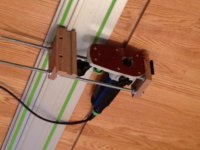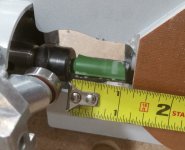DynaGlide
Member
- Joined
- May 16, 2017
- Messages
- 1,588
Out of all the Festool tools the MFK 700 has to be the winner in terms of trouble wrapping my head around its usage and applications. In the US it comes in two variants, the MFK 700 EQ SET 574368 and the MFK 700 EQ/B-Plus 574456. Over in Europe and elsewhere they make it even more confusing with an OFK variant.
Having just taken the Cabinets and Doors and Drawers class in Asheville last week I wanted to share a few notes while they're fresh in my mind to maybe help others figure this tool out. This is going to be a quick rundown and I'm sure I'll leave a lot out but hopefully others will chime in.
My reason for wanting the MFK 700 was for iron on edgebanding. I have a nice quad trimmer from Fastcap and it inevitably gives me a lot of tearout and not the finish I'd like. For this purpose the MFK is fantastic, if not a little overkill. The set version includes an offset horizontal base and a vertical base. The horizontal base is the one for trimming edge banding but it is offset a degree and a half so as to not ruin the surface finish of a counter top if it is laminated. I didn't use the vertical base much but in the class we used it along with the edge guide to run the 1/4" or 6mm dado to receive the back panel in the cabinets.
The EQ/B-Plus variant only comes with a vertical base (Festool 500590) that is offset with a bearing follower/brake. I never understood why anyone would want this. This is the "Conturo" version. What it's good for: say you're using PVC edgebanding. The base has a step in it so you can put the router over your edgebanding and onto the surface of the material the edgebanding is applied to without resting on the edgebanding itself as you bring the router forward to mill the edgebanding off. Easier to show than explain. The bearing brake stops the bearing of the bit from ruining the PVC edging as it spins at thousands of RPM's. You use this base with a combination edgebanding trimmer and roundover bit (i.e. Festool 499809) that will clean up and soften the transition of the edgebanding to the surface in one go. With the set version these are separate operations that require a bit change and possibly a base change.
For doing the cabinet backs Festool sells a rather pricey 6mm bit that fits the MFK 700 (490980). It took me a while but I found CMT 191.007.11 which is 1/4" diameter, 3/4" CL, and 2" overall length. That last part is what matters a lot with this router. Anything longer and I don't think you'd be able to chuck the bit into the router enough to do a 9mm deep groove in 18mm material to receive a 6mm or 1/4" back panel.
An unofficial use of the MFK 700 is that it will insert vertically into either the 0 degree or 1.5 degree horizontal bases. Then you can use a very short mortising bit like CMT 801.128.11 to flush trim protruding dowels, dominos, etc. A member here [member=4105]tjbnwi[/member] did a video demonstrating this operation:
In summary what seems like a one trick pony router has a lot more uses than I ever thought from first look. All the knobs on the bases and attachments are confusing but when you start using it they all make sense like most everything else Festool makes. This router is not officially supported for guide rail use which is a real shame given that the depth of the bit is adjustable in 1/10 mm increments. Microfence makes an adapter or you can make one yourself if you take a look at Jerry Work's guide on the subject. If there's enough interest I'll try to get some pictures up but so much of this has been covered already by others.
I hope this helps
Having just taken the Cabinets and Doors and Drawers class in Asheville last week I wanted to share a few notes while they're fresh in my mind to maybe help others figure this tool out. This is going to be a quick rundown and I'm sure I'll leave a lot out but hopefully others will chime in.
My reason for wanting the MFK 700 was for iron on edgebanding. I have a nice quad trimmer from Fastcap and it inevitably gives me a lot of tearout and not the finish I'd like. For this purpose the MFK is fantastic, if not a little overkill. The set version includes an offset horizontal base and a vertical base. The horizontal base is the one for trimming edge banding but it is offset a degree and a half so as to not ruin the surface finish of a counter top if it is laminated. I didn't use the vertical base much but in the class we used it along with the edge guide to run the 1/4" or 6mm dado to receive the back panel in the cabinets.
The EQ/B-Plus variant only comes with a vertical base (Festool 500590) that is offset with a bearing follower/brake. I never understood why anyone would want this. This is the "Conturo" version. What it's good for: say you're using PVC edgebanding. The base has a step in it so you can put the router over your edgebanding and onto the surface of the material the edgebanding is applied to without resting on the edgebanding itself as you bring the router forward to mill the edgebanding off. Easier to show than explain. The bearing brake stops the bearing of the bit from ruining the PVC edging as it spins at thousands of RPM's. You use this base with a combination edgebanding trimmer and roundover bit (i.e. Festool 499809) that will clean up and soften the transition of the edgebanding to the surface in one go. With the set version these are separate operations that require a bit change and possibly a base change.
For doing the cabinet backs Festool sells a rather pricey 6mm bit that fits the MFK 700 (490980). It took me a while but I found CMT 191.007.11 which is 1/4" diameter, 3/4" CL, and 2" overall length. That last part is what matters a lot with this router. Anything longer and I don't think you'd be able to chuck the bit into the router enough to do a 9mm deep groove in 18mm material to receive a 6mm or 1/4" back panel.
An unofficial use of the MFK 700 is that it will insert vertically into either the 0 degree or 1.5 degree horizontal bases. Then you can use a very short mortising bit like CMT 801.128.11 to flush trim protruding dowels, dominos, etc. A member here [member=4105]tjbnwi[/member] did a video demonstrating this operation:
In summary what seems like a one trick pony router has a lot more uses than I ever thought from first look. All the knobs on the bases and attachments are confusing but when you start using it they all make sense like most everything else Festool makes. This router is not officially supported for guide rail use which is a real shame given that the depth of the bit is adjustable in 1/10 mm increments. Microfence makes an adapter or you can make one yourself if you take a look at Jerry Work's guide on the subject. If there's enough interest I'll try to get some pictures up but so much of this has been covered already by others.
I hope this helps


